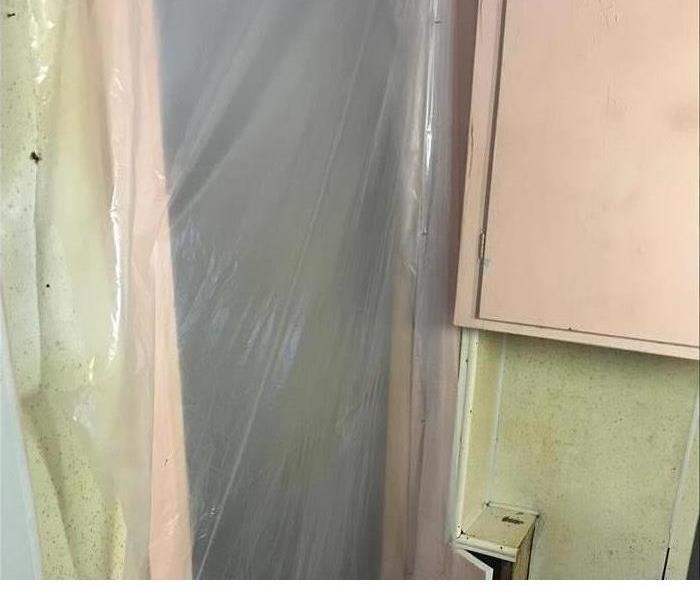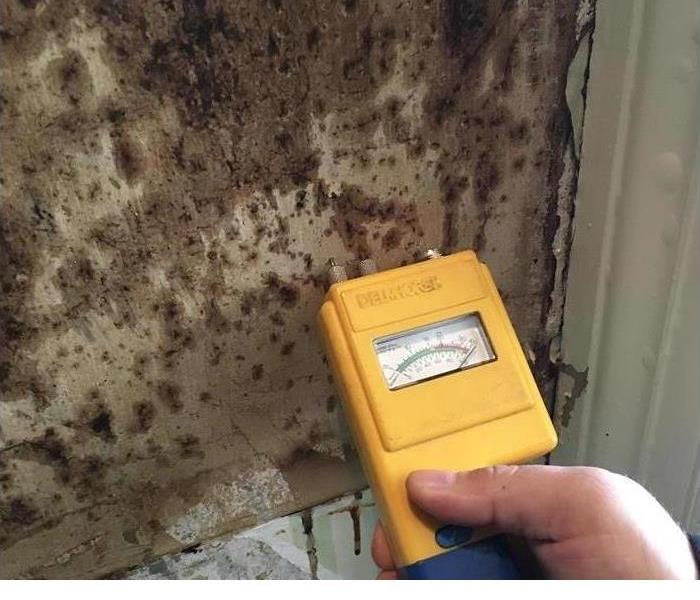Recent Mold Remediation Posts
Got A Mold Infestation? Let Our Team Help Restore Your Home In Reading!
2/12/2019 (Permalink)
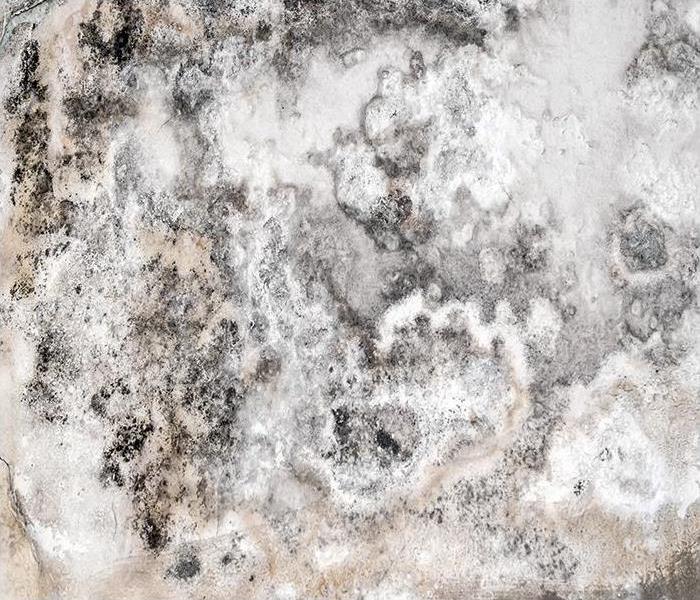 If you suspect there may be active, growing mold in your home, call us today at (610) 779-8189 to schedule one of our inspectors.
If you suspect there may be active, growing mold in your home, call us today at (610) 779-8189 to schedule one of our inspectors.
Mold Cleanup And Disposal Actions In Reading
Homeowners in Reading, especially those living along the banks of the Schuylkill River, have a healthy respect for what flooding can do to their residences. What many do not realize is their home can also see a mold infestation begin if it is not dried thoroughly after removing the water.
Mold cleanup in Reading homes and other communities after an infestation is not a simple process, but SERVPRO takes every step we can to preserve property and return every item possible to the owner promptly. Our restoration teams need to eliminate the source of moisture that allowed the mold to grow, clean and eliminate the threat of mold spores to property, and remove items too infested for restoration.
Water missed after removal is usually a small amount in an out-of-the-way location such as behind a wall or underneath a washing machine or cabinet inside the garage or laundry room. One of our inspectors uses an air content meter to measure mold spore levels and follow the highest concentration to the source of the infestation. This location is most often the moisture source as well.
SERVPRO technicians can quickly dry the pool or puddle using a commercial water vacuum, sponges, or cloths. They can also perform minor repairs if there is a leaky pipe or a seep in an outer wall that is letting in water from outside the home. Eliminating the moisture source stops growth completely, eventually forcing the spores back to an inert state.
Next, team members spray all visible mold with an anti-fungal agent. That kills active spores and prevents further growth, eliminating the further threat to the home. Now, they begin removing inert spores from affected items. In most cases, that means using sponges with a mild cleaner to wipe down the surfaces.
If active spores had time to grow into a property item like drywall panels, technicians carefully remove them, break them down if needed, bag them to prevent contaminating other areas of the home, and then dispose of them according to state and federal regulations.
Our end task at SERVPRO of Reading is to eliminate active mold spores in area homes and return them safe for reoccupation to the owner as quickly as we can safely do so. If you suspect there may be active, growing mold in your home, call us today at (610) 779-8189 to schedule one of our inspectors. We are here for you.
Click here for more about Reading.
You Need Our Help When Your Reading Home Is Taken Over By A Mold Infestation
2/6/2019 (Permalink)
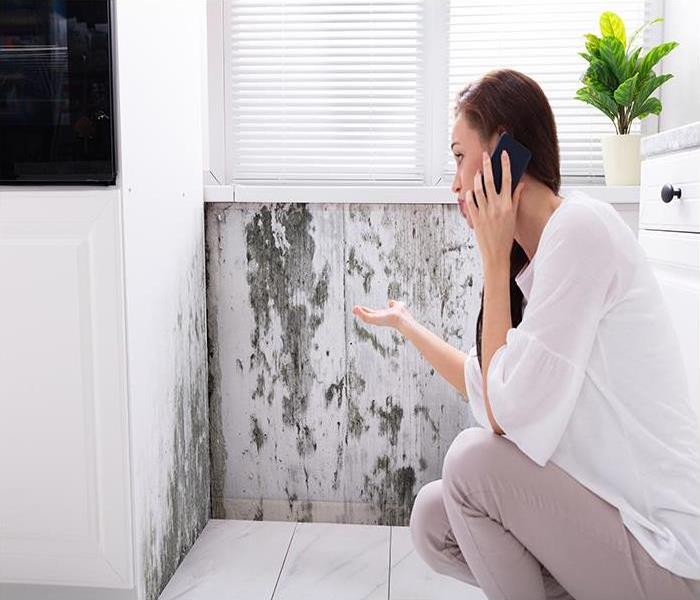 If you notice mold on more than one item in your home, call SERVPRO of Reading at (610) 779-8189 seven days a week.
If you notice mold on more than one item in your home, call SERVPRO of Reading at (610) 779-8189 seven days a week.
Reading's Mold Clean Out Technicians Describe A Scenario Where Multiple Objects Get Contaminated
Excessive humidity levels or a water leak that goes unnoticed inside your Reading home can both cause microbes that naturally exist to activate. Once a fungus forms, it is wise to call in a professional mold clean out firm such as SERVPRO before it spreads to other areas. Fungi need the right temperature, an organic food source, moisture and time before the microbes start developing structures called hyphae. These hyphae can grow rapidly and can expand in all three directions. Once they develop the structures start releasing seed-like spores into the air that flow around until they find a place to settle. During any mold clean out project our technicians take special care to keep spores from spreading and negatively affecting other areas of your home.
However, sometimes the contamination can spread quickly and affect multiple objects inside your house. If several items inside a building stay wet for too long, the mold clean out project in Reading could take several steps and is best tackled by restoration professionals like our SERVPRO technicians. For example, if a slow leak develops from a window, the moisture could cause contamination to develop on your drywall, the studs behind your walls, your carpets, any furniture you have in the area, or all of the above. Once a fungus forms on one organic substance on your home the spores can get onto other wet materials and form more hyphae structures. In these situations, the contamination must get removed before the fungi spread to other areas.
The first step our SERVPRO technicians takes when removing contaminated materials is to build a plastic barrier that seals any loose particles or dust created during the removal process. Once a containment chamber is set up, we remove any materials that got ruined and cannot be saved by disposing of them in sealed plastic bags. Next, we scrape off any contamination we find wooden materials or other items we think we can save.
If you notice mold on more than one item in your home, call SERVPRO of Reading at (610) 779-8189 seven days a week.
Click here for more about Reading.
Know the Differences Between Mold and Mildew
9/13/2018 (Permalink)
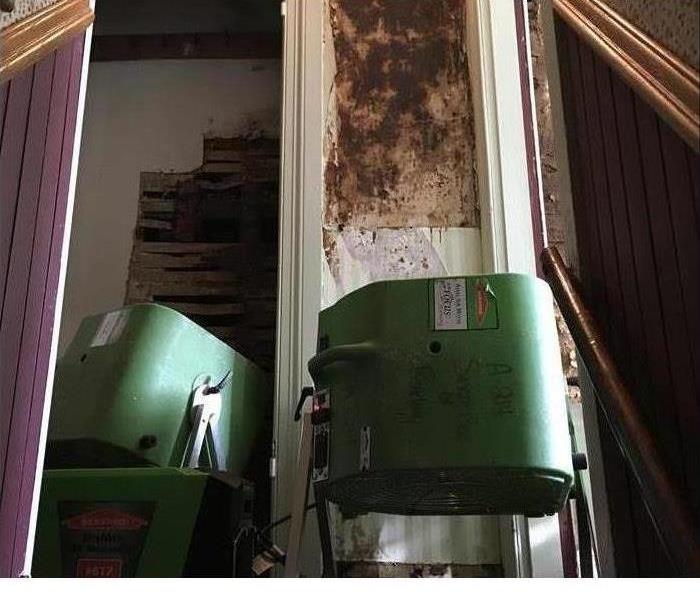 Mold damage after a pipe break on the wall in Reading, PA
Mold damage after a pipe break on the wall in Reading, PA
If you own a home in Reading, PA, chances are you have experience with mold damage or mildew growth. You might have found some mold growth on an old rug in the basement, or some mildew on clothes or rags left in a damp area. But are mold and mildew the same?
Mold and mildew are somewhat similar, in that they both:
- Thrive in moist areas
- Like warm environments
- Are fungi that spread through spores
- Can grow on a wide variety of surfaces
But despite the similarities, mold and mildew have very distinct differences.
Mildew
Mildew is a specific form of fungus that generally forms on damp surfaces, and is powdery or fluffy in appearance. It's usually found in the home on moist surfaces, fabrics, paper, and on other organic materials. Outside of the home, mildew often causes a great deal of damage to agricultural products such as potatoes and grapes. There are two main types: downy mildew and powdery mildew. Downy mildew can vary in appearance but generally starts out with yellowish spots that turn brown after a time. Powdery mildew starts out as gray or white blotches that eventually become yellow-brown. Unlike mold, mildew can be removed fairly easily with a specialized cleaner and a scrubbing brush.
Mold
Mold is usually green or black with a fuzzy or slimy appearance. It is much more invasive than mildew, as it thrives under surfaces like the interiors of walls or under floorboards. Unlike mildew, mold damage can be far more harmful and much harder to get rid of once it's established. Also, there are a much wider variety of molds, the five most prevalent being penicillium, cladosporium, aspergillus, alternaria, and stachybotrys chartarum, or black mold. Unlike mildew, a mold problem is usually much more difficult to get rid of.
Mildew can be fully eliminated with a little effort on your part, but mold damage may require the skills of a professional mold mitigation company. Eradicating mold and mildew in your home is easy if you act promptly to get rid of it.
What Does Mold Containment and Remediation Involve?
5/13/2018 (Permalink)
So you’ve found mold in your Reading, PA, home. While your first step should be to contact a mold remediation specialist, while you wait for help you need to stop the spread of mold contamination and initiate proper containment prior to remediation. Containment can keep mold from spreading to uncontaminated areas – but what does mold containment and remediation actually entail?
Steps to Take for Mold Containment
Mold contamination is so serious even the CDC addresses it with guidelines for containment and remediation. For containment, you should:
1. Immediately shut off water around the affected area. Water feeds mold, and you may have a leak or broken pipe that’s making the issue worse.
2. Blot the affected area as dry as possible. Any standing water is just giving mold more fuel to breed, so dry up any water. Use gloves, as the water may contain mold contamination.
3. Shut off HVAC systems. Mold spores can spread through HVAC systems and contaminate other areas of the house.
4. Remove contaminated materials and dispose of them appropriately. Your carpet may have picked up a mold infestation, or items of clothing lying around. You may need to wait for remediation for a full tear-out, but get rid of anything disposable ASAP.
5. Seal off the area. If possible, close off the area with an airtight seal. Tape windows and doors, and close and cover air vents.
6. Use antifungals and mold prevention solutions on the rest of the house. You can use off-the-shelf antifungals as a spray defense to ward the rest of your house against the spread of mold.
What Remediation Involves
A mold remediation specialist will not only check the discovered infestation, but inspect your entire house thoroughly to identify any other sources of mold. The type of mold and the depth of the contamination will determine what remediation may involve, from use of HEPA air filters to a complete tear-out of infested drywall, flooring, or carpeting.
For more information, please visit us at http://www.SERVPROreading.com.
Proper Standards for Mold Cleanup in a Commercial Facility
4/27/2018 (Permalink)
You may be surprised to realize that the EPA and OSHA have not set mold standards when it comes to the cleanup of this tricky substance. Despite that, there are some ways you can ensure your building in Reading, PA, is protected from mold buildup. While the fungus is natural and can be found almost anywhere, mold that has the chance to grow can cause problems.
Cleaning Tips
If you discover your facility has excess amounts of mold, calling in professionals conversant with industry mold standards is your best option. If your staff are helping out with those efforts, there are a few things you can do to ensure the best possible results with cleaning:
• Wear protective gear when cleaning mold. Make sure your skin, eyes, mouth, and nose are protected.
• When you can use electricity, make sure dehumidifiers, and fans are set up to help remove moisture.
• Anything that was touched by flood or sewage water, but cannot be cleaned and dried within two days, should be thrown away.
• When using cleaning products, do not mix them as this can cause toxic vapors.
• Keep open windows and doors and cleaning to ensure safety for workers.
• Scrub down surfaces with detergent and water, then dry immediately.
Protective Gear
When you are considering protective gear to use during a mold clean, there are a few items that are helpful. First, you should have on protective gloves and waterproof boots to avoid exposure to water or black mold. Long pants and a shirt with long sleeves are also best to protect yourself. On top of that, you will likely want to wear goggles and an N-95 or better respirator. Follow the mold standards of the IICRC or other professional bodies to be as safe as possible.
Mold remediation efforts can be complex. Professional assistance and the tips above can help ensure you are safe while cleaning and your facility is back in order as quickly as possible.
For more information, please visit us athttp://www.SERVPROreading.com.
Potential Growth and Common Causes of Mold Growth
3/30/2018 (Permalink)
Molds are able to thrive indoors or out, provided the right moisture conditions exist.
These fungi disperse microscopic spores into the air, and they’re found almost everywhere. It’s important to quickly determine if any green or black mold found growing in the home is harmful, and if so, develop a remediation plan as soon as possible.
These are some of the situations which often lead to mold growth within a residential space:
- Leaks in your home’s water pipes;
- Excess moisture accumulating in a crawlspace or basement;
- Dampness resulting from wet weather and poor insulation, roofing problems, etc.
If evidence of this kind of growth is found in the home, it’s a good idea to have it tested promptly; visible molds frequently indicate more extensive growth in unseen locations. Remember that whether it’s green, gray or black mold, cleanup requires professional knowledge and equipment, so don’t attempt to tackle that moisture problem on your own. Visit http://www.SERVPROreading.com for more information on mold.
The Five Steps of Mold Remediation
3/28/2018 (Permalink)
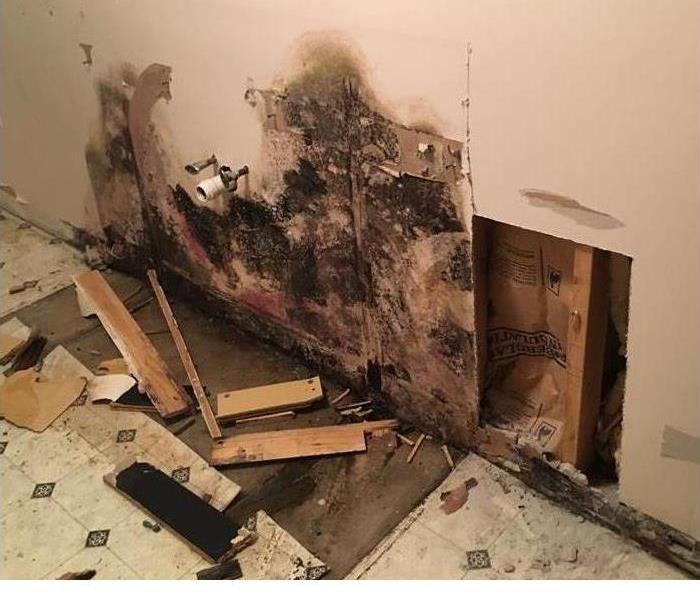
If your home is suffering from a serious black mold problem, you may have already contacted a mold remediation specialist in Reading, PA, to handle the cleanup. In the meantime, you might have a lot of questions about the mold in your house and what to expect when the mold remediation professionals show up at your door. Here are the five main steps of a professional mold cleanup:
1. Evaluation. The first thing a professional will do is evaluate your home to determine how extensive the problem is and determine the best way to handle it. They’ll also evaluate the situation after remediation is complete to make sure the mold is completely gone and the source of the problem has been dealt with.
2. Containment. The moldy area may be blocked off with plastic sheeting to prevent the spread of mold spores to other parts of your home. It’s also common for plastic sheeting to be laid down from the outside of your home all the way to the moldy area so that mold is not tracked through your house during remediation.
3. Personal Protection. Don’t be surprised if the crew is wearing face masks or full hazmat suit. It doesn’t mean your black mold is toxic, it’s just standard safety measures.
4. Removal / Cleanup. If the surface where mold is growing is porous, like carpet, drywall or wood, it will usually need to be physically removed. The mold grows into the tiny pores in these materials, making it virtually impossible to clean. If the material isn’t porous, it may be sprayed with a biocide, which kills the mold and cleans off any staining. It can then be sealed to make the material more resistant to mold and moisture.
5. Elimination of Moisture Source. A professional will also locate the source of your moisture problem and make sure it’s repaired. If the source of moisture isn’t dealt with, your mold problem will return.
Mold remediation is a straight-forward process, but it does require specialized equipment and knowledge. The professionals in Reading, PA, will have the experience to know how to handle your black mold.
For more information, please visit us at http://www.SERVPROreading.com.
3 Facts About Ice Dams and Mold
2/23/2018 (Permalink)
When winter arrives, it can affect your Reading, PA, commercial building in a variety of ways. The weight from heavy snow, high winds and melting ice can all cause damage, and not all of it is instantly visible. For example, an ice dam, which forms between layers of snow and your roofing, can build up anywhere on your roof and create ideal conditions for mold growth. The more you know about this ice buildup and its effects, the faster you may be able to spot and resolve it.
1. Ice Dams Are Common in Late Winter
While these dams can form at almost any time during cold weather, they are most common in late winter, when periods of thawing and freezing occur more frequently. The warmth of a sunny day, coupled with heat escaping from your building’s attic due to poor insulation, can cause the formation of an ice dam. Eventually, the trapped moisture may enter your business and cause mold to grow.
2. Cold Temperatures Do Not Kill Mold Spores
Mold commonly grows in humid, moist places. However, this does not exclude the possibility of mold growth due to ice dams. Some species are quite resistant to cold weather, such as black mold. While freezing temperatures may slow the growth somewhat, the fungus can return and grow rapidly, which may cause unpleasant odors at your business.
3. Professional Inspection Can Protect Your Business
Having a company that specializes in mold inspection and remediation inspect your commercial building can prevent further growth of this damaging substance. Remediation experts can also handle any necessary mold cleanup you may require. Most species do not respond to commercial cleansers, so it is wise to let professionals perform these services.
The formation of an ice dam and other sources of moisture that may cause mold to grow in your Reading, PA, business can cause considerable damage. Staying aware of these conditions all winter long can help you protect your commercial building and prevent the growth and spread of mold.
For more information, visit http://www.SERVPROreading.com.
What Exactly is Mold and How Does It Grow?
11/28/2017 (Permalink)
It’s extremely common throughout the world, it’s found in most homes in some form and all it needs to grow is sufficient moisture. Mold is a naturally occurring fungus, and its role in processes like biodegradation makes it essential to a healthy ecosystem. These types of fungi can also prove harmful however, such as when a moisture problem leads to growths within the home, including black mold.
Residential Woes
Indoor molds can be a major issue in City, State, threatening property while also causing potential health issues for people and pets. They can produce irritants and allergens, or potentially even mycotoxins, any or all of which may affect respiratory health. These types of problems may be more pronounced for those with existing ailments or allergies causing heightened sensitivity, making mold cleanup a crucial must for many families. Keeping a qualified mold remediation professional among your contacts is advisable for any homeowner.
Visit http://www.SERVPROreading.com for more information on mold.
The Dangers of Toxic Mold
8/14/2017 (Permalink)
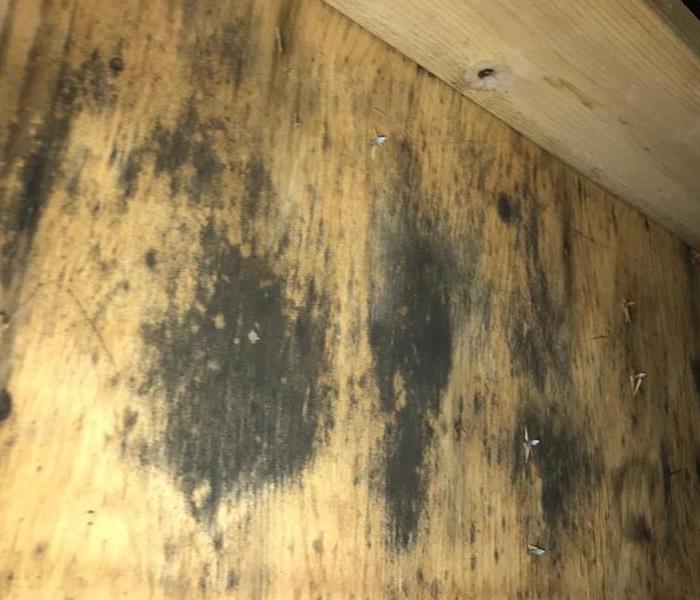 Mold growth on attic ceiling.
Mold growth on attic ceiling.
Facts about mold:
- Mold in your home, school, or workplace is a serious concern for your health, since up to 40 percent of American schools and 25 percent of homes have mold infestations.
- Mycotoxins, or the toxins some molds produce, can cross into your brain from your nose and eyes. Some of the more neurotoxic molds can cause central nervous system effects, such as cognitive and behavioral changes, ataxia, and convulsions.
- Two of the better-known toxic molds include Stachybotrys chartarum ("black mold"), which can cause everything from headaches to cancer, and Aspergillus, which can cause severe lung infections, or progress to whole-body infections.
- Mold is particularly dangerous for infants and children. There is evidence that some cases of SIDS may be related to toxic mold exposure.
Stachybotrys Chartarum: The Dreaded 'Black Mold'
Stachybotrys chartarum (SC)7 is a greenish black mold that grows on material with high cellulose content, such as wood, straw, hay, wicker, cardboard, fiberboard, etc., particularly when these materials become water-damaged. It needs a good deal of dampness to flourish. According to Mold-Help.org,8 the toxic effects of Stachybotrys chartarum were first reported in the 1920s in Russia when horses and cattle that had eaten moldy hay began dying. The "Yellow Rain" attacks in Southeast Asia in the 1970s were associated with aerosolized trichothecenes, the type of mycotoxin produced by this highly toxic type of mold.
SC is typically dark in color and wet and slimy to the touch. It can also appear grayish or sooty, with a powdery appearance.
However, it's important to remember that molds cannot be identified visually—many molds are similar in appearance.
Cladosporium, Aspergillus, Alternaria, and Drechslera, can be mistaken for Stachybotrys. The only definitive way to identify a species is by examination of the spores under a microscope, which is why professional testing is so important.
According to Mold-Help.org:
"Most people are not aware that harmful molds come in a variety of colors—they can be white, or orange, or blue, for instance. The color of a mold generally has to do with the spores it produces, and has no bearing on whether it is dangerous or not. There are some white molds that grow on walls and other surfaces that can be just as bad as the harmful black molds."
Mycotoxin poisoning by Stachybotrys is referred to as stachybotryotoxicosis. In animal studies, trichothecenes are 40 times more toxic when inhaled than when ingested orally. But even if SC is present in your environment, you may not be at risk because it may not be currently releasing toxins.
Again, according to Mold-Help.org:10
"Laboratory studies indicate that molds such as Stachybotrys that have the ability to produce toxins do not always do so. Whether a mold produces a toxin while growing in a building may depend on what the mold is growing on, conditions such as temperature, food, pH, humidity or other unknown factors. When mycotoxins are present, they occur on spores and the small mold fragments that may be released into the air."
The spores from SC can survive temperatures up to 500 degrees F, as well as surviving caustic agents like bleach and acid. According to Dr. Michael Gray, spores from molds removed from two million year-old sedimentary rocks have grown when placed in a favorable media!
If your home shows any signs of mold give SERVPRO a call today at 610-779-8189 or 570-622-8991 and let us give you an estimate and protect your health!
Does Your Home Have A Mold Problem?
6/15/2017 (Permalink)
Microscopic mold spores naturally occur almost everywhere, both outdoors and indoors. This makes it impossible to remove all mold from a home or business. Therefore, mold remediation reduces the mold spore count back to its natural or baseline level. Some restoration businesses advertise “mold removal” and even guarantee to remove all mold, which is a fallacy. Consider the following mold facts:
- Mold is present almost everywhere, indoors and outdoors.
- Mold spores are microscopic and float along in the air and may enter your home through windows, doors, or AC/heating systems or even hitch a ride indoors on your clothing or a pet.
- Mold spores thrive on moisture. Mold spores can quickly grow into colonies when exposed to water. These colonies may produce allergens and irritants.
- Before mold remediation can begin, any sources of water or moisture must be addressed. Otherwise, the mold may return.
- Mold often produces a strong, musty odor and can lead you to possible mold problem areas.
- Even higher-than-normal indoor humidity can support mold growth. Keep indoor humidity below 45 percent.
If your home or business has a mold problem, we can inspect and assess your property and use our specialized training, equipment, and expertise to remediate your mold infestation.
 If you suspect there may be active, growing mold in your home, call us today at (610) 779-8189 to schedule one of our inspectors.
If you suspect there may be active, growing mold in your home, call us today at (610) 779-8189 to schedule one of our inspectors.

 24/7 Emergency Service
24/7 Emergency Service


